Related Research Articles

The wrasses are a family, Labridae, of marine fish, many of which are brightly colored. The family is large and diverse, with over 600 species in 81 genera, which are divided into 9 subgroups or tribes. They are typically small, most of them less than 20 cm (7.9 in) long, although the largest, the humphead wrasse, can measure up to 2.5 m (8.2 ft). They are efficient carnivores, feeding on a wide range of small invertebrates. Many smaller wrasses follow the feeding trails of larger fish, picking up invertebrates disturbed by their passing. Juveniles of some representatives of the genera Bodianus, Epibulus, Cirrhilabrus, Oxycheilinus, and Paracheilinus hide among the tentacles of the free-living mushroom corals and Heliofungia actiniformis.

The humphead wrasse is a large species of wrasse mainly found on coral reefs in the Indo-Pacific region. It is also known as the Māori wrasse, Napoleon wrasse, Napoleon fish, Napoleonfish, so mei 蘇眉 (Cantonese), mameng (Filipino), and merer in the Pohnpeian language of the Caroline Islands.

The ballan wrasse is a species of marine ray finned fish from the family Labridae, the wrasses. It is found in the eastern Atlantic Ocean, where it inhabits rocky areas. Like many wrasse species, it is a protogynous hermaphrodite—all fish start life as females, and some dominant fish later become males. It is used as a food fish in some areas and it is also finding use as a cleaner fish in the aquaculture of Atlantic salmon in northwestern Europe.

The slippery dick is a species of wrasse native to shallow, tropical waters of the western Atlantic Ocean.

Cleaner fish are fish that show a specialist feeding strategy by providing a service to other species, referred to as clients, by removing dead skin, ectoparasites, and infected tissue from the surface or gill chambers. This example of cleaning symbiosis represents mutualism and cooperation behaviour, an ecological interaction that benefits both parties involved. However, the cleaner fish may consume mucus or tissue, thus creating a form of parasitism called cheating. The client animals are typically fish of a different species, but can also be aquatic reptiles, mammals, or octopuses. A wide variety of fish including wrasse, cichlids, catfish, pipefish, lumpsuckers, and gobies display cleaning behaviors across the globe in fresh, brackish, and marine waters but specifically concentrated in the tropics due to high parasite density. Similar behaviour is found in other groups of animals, such as cleaner shrimps.
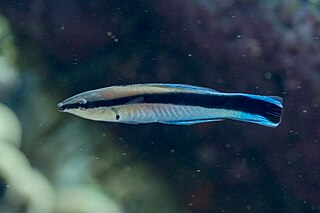
The bluestreak cleaner wrasse, Labroides dimidiatus, is one of several species of cleaner wrasses found on coral reefs from Eastern Africa and the Red Sea to French Polynesia. Like other cleaner wrasses, it eats parasites and dead tissue off larger fishes' skin in a mutualistic relationship that provides food and protection for the wrasse, and considerable health benefits for the other fishes.

The cuckoo wrasse is a species of wrasse native to the eastern Atlantic Ocean from Norway to Senegal, including the Azores and Madeira. It is also found in the Mediterranean Sea. They occur in weedy, rocky areas mostly between 40 and 80 m. This species is an occasional food fish for local populations but is also popular as a game fish. It is also a popular fish for display in public aquaria.
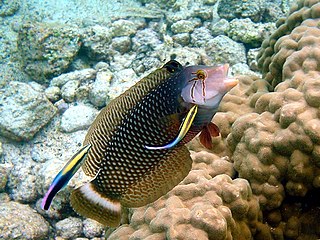
Novaculichthys taeniourus, also known as the rockmover wrasse, carpet wrasse, dragon wrasse, bar-cheeked wrasse, olive-scribbled wrasse or reindeer wrasse, is a species of wrasse mainly found in coral reefs and lagoons in the Indo-Pacific region. These include habitats in the Gulf of California to Panama; tropical Pacific Ocean islands including Hawaii; the Philippines, Indonesia and Australia; and the Indian Ocean to the east coast of Africa. The common name, "rockmover wrasse", comes from their behavior of upending small stones and reef fragments in search of prey. This species is the only known member of its genus.
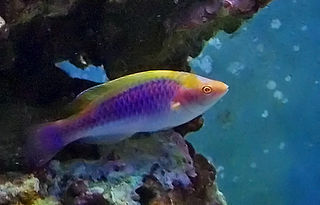
Lubbock's wrasse, Cirrhilabrus lubbocki, is a species of wrasse native to coral reefs of the Philippines and the island of Sulawesi in Indonesia, though it also has been claimed to be present in Malaysia, Japan, and Palau. It can be found at depths from 4 to 45 m, though rarely deeper than 30 m (98 ft). This species can reach a total length of 8 cm (3.1 in). It can be found in the aquarium trade.
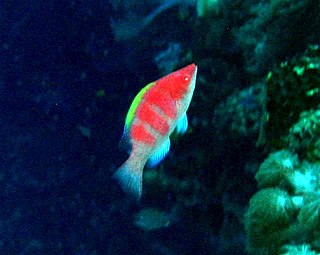
The yellowfin fairy-wrasse is a species of wrasse native to the western Pacific Ocean from Indonesia to the Philippines and Palau. It inhabits coral reefs, living in groups among the branches of branching coral. It can be found at depths from 6 to 40 m, though rarely deeper than 28 m (92 ft). This species can reach a total length of 6.5 cm (2.6 in).
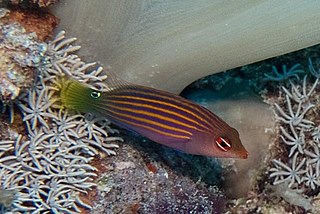
The six-line wrasse is a species of marine ray-finned fish from the family Labridae which has a wide Indo-Pacific distribution. This species is associated with coral reefs and can be found in the aquarium trade.

The sixbar wrasse or six-banded wrasse is a species of wrasse in the family Labridae, native to the Indian Ocean and the western Pacific Ocean. It is an inhabitant of reef environments at depths from the surface down to 15 m (50 ft). This species can grow to 20 cm (8 in) in total length, though most individuals do not exceed 15 cm (6 in). It is of minor importance to local commercial fisheries and can also be found in the aquarium trade.

The creole wrasse is a species of wrasse native to the western Atlantic Ocean.

The yellowtail tubelip (Yellowtail Tubelip wrasse or Diproctacanthus xanthurus), is a species of wrasse native to coral reefs of the western central Pacific Ocean near Palau, Indonesia, Great barrier reef, Philippines and New Guinea at depths from 3 to 25 m. The juveniles act as cleaner fish, while the adults primarily prey on coral polyps. The D. xanthurus species grows to a total length of 10 cm (3.9 in). It can be found in the aquarium trade. This species is the only known member of its genus. Other common names for the yellowtail tubelip are cleaner wrasse, Wandering cleaner wrasse, yellowtail wrasse, lulukdayan etc.
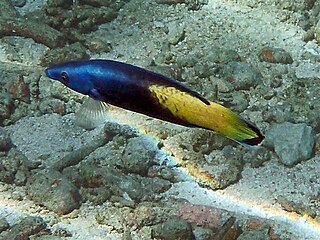
Labroides bicolor is a species of wrasse endemic to the Indian Ocean and the Pacific Ocean. It is known by various names including bicolor cleanerfish, bicolor(ed) cleaner wrasse, cleaner wrasse, two-color cleaner wrasse and yellow diesel wrasse.
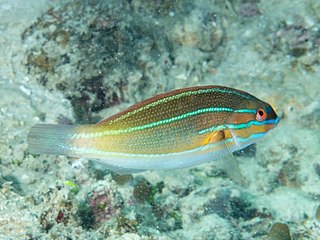
Stethojulis trilineata, also known as the blue-ribbon wrasse, red shouldered rainbow-fish, scarlet-banded rainbowfish, three-blueline wrasse, three-lined rainbowfish or three-lined wrasse, is a species of marine ray-finned fish, a wrasse from the family Labridae. It is found in the Indo-Pacific region where it is associated with reefs.
Bodianus neopercularis, is a species of wrasse from the family Labridae which is native to tropical and warm temperate waters of the Indo-West Pacific, particularly the Marshall Islands. A record of Bodianus opercularis from Palau has now been reidentified as this species.

Labriformes is an order of ray-finned fishes which includes the wrasse, cales and parrotfishes, within the clade Percomorpha. Some authors include the Labroformes as the clade Labroidei within the Perciformes while others include more families within the Labriformes, such as the cichlids and damselfishes, but the 5th edition of Fishes of the World includes just three listed in the section below and includes 87 genera and about 630 species.

Latent sling-jaw wrasse is a species of ray-finned fish from the wrasse Family Labridae which is associated with reefs in the south-western Pacific Ocean.

Cirrhilabrus earlei is a species of fairy wrasse. They occur in the Western Central Pacific, Palau and Micronesia. In 2001 John Randall and Richard Pyle officially documented and described the species. Cirrhilabrus earlei is the known to the twilight reefs of Palau and the Majuro Atoll in the Marshall Islands. They live under depth range of 60–92 m, and its length is 6.9 cm SL. Male Cirrhilabrus earlei are adorned with sword-shaped tails, the tiny female species are same as male stimulates the male into the nuptial.
References
- ↑ "Fish Species in Palau". FishNet. Retrieved December 25, 2021.